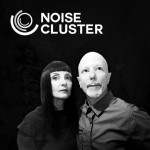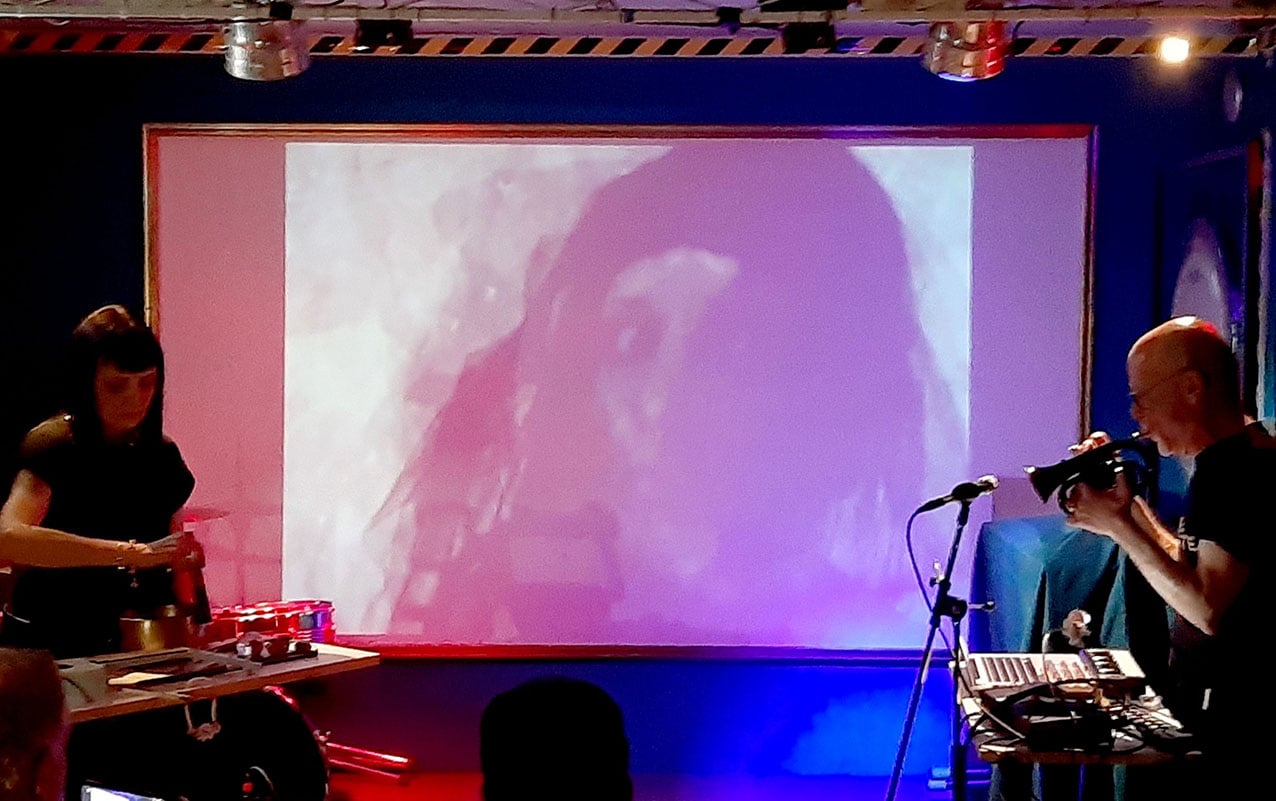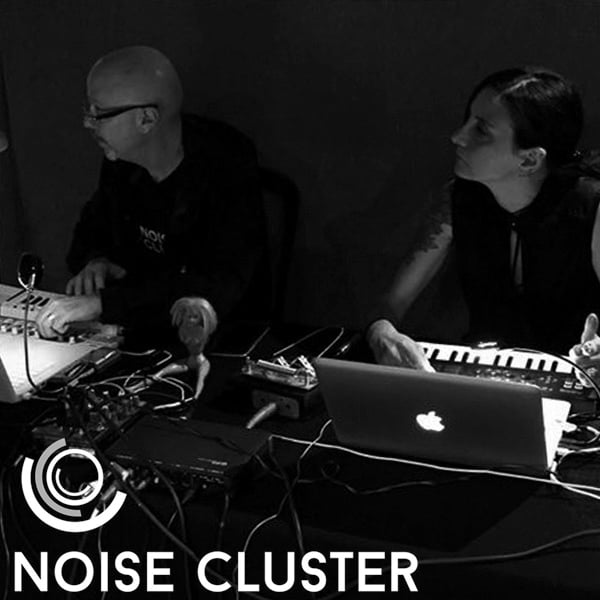 For years, the Roman duo Noise Cluster, consisting of Flavio Derbekannte and Arianna Degni Lombardo, have been exploring the boundaries of electronic music. Their works are characterized by a unique mixture of experimental sound art, narrative concepts and a penchant for dark themes, their stylistic range extends from noisy approaches to club-friendly, monumental electronics to psychedelic soundscapes, and one of the leitmotifs is always Flavio’s trumpet, which is not always clearly in the center, but still draws a connection to his early work, when he made a name for himself as Der Bekannte Post-Industrielle Trompeter (The Notorious Post Industrial Trumpet Player). Arianna, who was previously active as Xxeena, puts her stamp on the project not only through her involvement in the productions, but also through her voice and her characteristic illustrations. With the new tape “To the Moon and Back” (Grubenwehr Freiburg), a collaboration with Cristiano Bocci, they take listeners on a musical space journey that touches on both astronomical and mythological dimensions. In the following conversation, Noise Cluster talk about the origins and the years-long history of the project, their creative approach and the importance that mythological subjects, but also aspects of darkness and alienation, have in their music.
For years, the Roman duo Noise Cluster, consisting of Flavio Derbekannte and Arianna Degni Lombardo, have been exploring the boundaries of electronic music. Their works are characterized by a unique mixture of experimental sound art, narrative concepts and a penchant for dark themes, their stylistic range extends from noisy approaches to club-friendly, monumental electronics to psychedelic soundscapes, and one of the leitmotifs is always Flavio’s trumpet, which is not always clearly in the center, but still draws a connection to his early work, when he made a name for himself as Der Bekannte Post-Industrielle Trompeter (The Notorious Post Industrial Trumpet Player). Arianna, who was previously active as Xxeena, puts her stamp on the project not only through her involvement in the productions, but also through her voice and her characteristic illustrations. With the new tape “To the Moon and Back” (Grubenwehr Freiburg), a collaboration with Cristiano Bocci, they take listeners on a musical space journey that touches on both astronomical and mythological dimensions. In the following conversation, Noise Cluster talk about the origins and the years-long history of the project, their creative approach and the importance that mythological subjects, but also aspects of darkness and alienation, have in their music.
You’ve just released a new tape titled “To The Moon and Back,” a collaboration with another musician. How did the idea to work with Cristiano Bocci come about? Have you known each other or been familiar with each other’s work for a long time?
Before even answering your very interesting questions, let us thank you and your readers for the time and attention you’re dedicating to us! we are truly honored!
We met Cristiano through the listening group of a DJ who hosts a historic and very important industrial music show on an Italian independent radio station. Over time, the community grew, and this year Cristiano proposed creating a compilation to celebrate Giacomo’s, the DJ, birthday, and to help fund the radio station. Many artists participated in the compilation, both solo and in spontaneous collaborations. We collaborated with Cristiano ourselves, and being very satisfied with the track we created together, we decided to develop a full album. Our friend David Grodock from Freiburg graciously agreed to produce it.
How would you evaluate the collaboration with Cristiano Bocci in terms of the sound and atmosphere of the album? What new atmospheric elements did he introduce with his bass playing? It’s certainly an unusual element in your discography.
As you know, we’ve previously collaborated with other musicians who explore territories and use instruments different from our own. We deeply believe in this type of interaction, which, in our opinion, enriches both projects.
In my review, I mentioned a psychedelic element in the sound and style of “To the Moon and Back”, which could stem from subjective association. Do you relate to this description of the album?
We think your impression is correct, especially regarding the sung pieces. The overall atmosphere of the album is deliberately ambient and dreamlike, honoring the romantic satellite that intoxicates and inspires us with its ancient and mysterious allure.
When new ideas for tracks or albums come to mind, are they usually about sounds, compositions, or thematic content? Or does it vary?
For albums, we usually start from a concept or story—like Medusa, Mr. Mallory, or The Lost Dolls, and previous collaborations such as The Fall of the Universe with Lyke Wake or Stigmate (The Nightmare). The chosen theme guides the development of the sounds. However, we don’t follow fixed rules; for single tracks, we often gather sounds first, process them, and then build the piece.
Like your previous albums, this one also demonstrates a thematic concept—this time about a journey to the Moon, which can be understood as both an astronomical and mythological phenomenon. What attracted you to this theme, and how did the idea for the album come about?
The Moon has always been a mysterious and fascinating element, perhaps because it seems so close, yet we know so little about it. It has always inspired curiosity and emotions. The Moon appears in countless stories, from Tarot cards to science fiction, ancient myths, poetry, and shared imagination. It’s a fragment of our planet that has detached into space and serves as a bridge between us and the universe. We decided to dedicate a small tribute to it.
The journey to a distant place and back is often symbolically interpreted as an initiation, after which one enters a new phase of existence as a changed person. What might it mean to travel to the Moon and return?
Current technology and the “space trend” may have removed much of the charm tied to exploring the unknown, but we are convinced that the experience of a space journey could profoundly change a person’s sensitivity. It all depends on interpreting such an experience the right way: observing the world from the outside and then improving it, both internally and externally.
I’m curious about the origin of your unusual sound ideas, like the aquatic sounds in the pulsing framework of “Chariot Across the Skies”. Are these ideas premeditated, or do they arise spontaneously during experimentation?
As with album concepts, we don’t follow a single process for sounds. Sometimes we like to explore the possibilities of a synth or acoustic instrument and apply them to the track in progress. Other times, the piece itself guides our choice of sounds. For “Chariot…,” which represents the Moon’s phases or its “journey” across the sky as if drawn by ten divine horses, perhaps the imagery of silent, magical flight evokes immersion in a celestial ocean.
What’s the creative process behind a piece like “Endymion and Selene”? What steps do you follow to musically represent mythological figures?
The starting point is always the story, whether it’s our creation or, as in this case, from ancient mythology. Endymion, possibly a shepherd or an astronomer, gazes at his sky where Selene, the Moon goddess, resides. Their tumultuous relationship inspired the representation in this track.
Your albums often feature intense and diverse soundscapes. How do you balance a coherent sound with complexity in your compositions?
Every story has countless facets, characters, and situations, each lending itself to different styles and details. Look at the dramatic ballads of Perseus and Medusa versus the electronic gallop of Pegasus in the Gorgon album. Sounds and styles—even discordant ones—can all be aspects of the same concept.
Arianna, your voice takes on a distinctly theatrical quality in pieces like Eterna Sfera Celeste. What role does your voice play in expressing music today? Has your relationship with voice as a medium changed over time?
Initially, I, Arianna, used my voice solely as a sound to be processed and altered. Recently, I’ve ventured into both writing lyrics, as in pieces like Crackling World and Eterna Sfera Celeste, and their poetic interpretation, as in Perseus, Not a Hero, written by Flavio. Over the years, I’ve definitely gained more confidence in using my voice, even though I wouldn’t consider myself a singer by any means (laughs).
Many of your works carry an ominous and dark quality. What draws you to this dark aesthetic, and how do you translate it into sound?
We both come from inherently nihilistic backgrounds—dark and industrial—where everything is bleak, hopeless, and destructive. However, we’ve always tried to inject a sense of irony into the negativity of the world, attempting in some way to highlight it as a means of confronting it, even though, unfortunately, it always ends up prevailing. The sounds and words we put into music are simply the ‘materialization’ of our states of mind, which, especially in the historical context we live in, certainly cannot be light.
I’d like to talk about some of your earlier albums. Your previous album, Medusa, Who Else?, reimagines the mythological figure of Medusa while addressing contemporary themes like victim-blaming. How important is it for you to address socially relevant topics in your music?
“Medusa, Who Else?” is certainly not the first concept album we’ve created, but earlier ones had a more grotesque and somewhat ‘autobiographical’ tone. Take, for example, The Outstanding Story of Mr. Mallory and its sequel, The Return of Mr. Mallory as well as Lympha Obscura, released under DBPIT & XXENA, or our first release as Noise Cluster, The Planet of the Lost Dolls, which transposes an earthly legend into a sci-fi setting.
There was also IHSV under DBPIT & XXENA, a dark harsh-noise tape condemning ecclesiastical censorship. However, Medusa, Who Else? is perhaps our first work fully dedicated to a current socio-political issue.
Music has always been an important vehicle for spreading ideas beyond mere entertainment, and we felt it was time to give a voice to victims unjustly sacrificed.
Do you think a key strength of myths like Medusa’s is their ability to be symbolically or allegorically applied to different issues and situations?
Absolutely. Ancient myths are born from human archetypes, such as the relationship between humans and nature, the fear of the divine, and the psychology of the human race. In this sense, they are timeless stories that explore humanity’s weaknesses and hopes, themes that are perpetually relevant.
The album was released in an unconventional format with a poster and a download code. What thoughts on materialism and the fetishization of physical objects in the music world are reflected in this choice?
Thank you so much for this question; unfortunately, not everyone understood or appreciated our intent, but we wanted to make a clear statement by dematerializing the music in Medusa.
Music exists in the air, in our ears, in our minds—it doesn’t depend on the medium that reproduces it. We feel that CDs have become obsolete; new car stereos and computers no longer include CD players, and CDs lack the ritualistic charm of vinyl or even cassettes, which we still appreciate.
By choosing not to circulate more unnecessary plastic discs, we hoped to send a message of environmental conservation. Naturally, since Arianna is a talented illustrator, we paired the digital download with a unique graphic artwork reminiscent of 12″ inserts, offering audiences a collectible and displayable item.
In our view, this is the right direction to take.
In “Extreme Sleepwalking”, you and Sardinian analog virtuoso Stigmate explored themes like nightmares and a sleepwalking existence (even in a figurative sense). What drew you to this subject?
Initially, we were inspired by the idea of exploring mythological monsters from Eastern traditions, but we ended up confronting our personal demons instead (laughs). The theme of nightmares and an almost zombified existence resonated deeply, especially given the context of the pandemic when this project was born.
The album was created during the pandemic. Did the crisis have a direct influence on the mood or the overall topics of the album?
Absolutely. That wonderful collaboration was shaped profoundly by the circumstances of the pandemic. We were all essentially like zombies, confined to our homes, grappling with fears and the monsters of our subconscious that emerge during sleep.
Our psyche was tested (as if today we’re all serene, right?), confronted with an invisible enemy whose nature and countermeasures were uncertain. It was a strange time. From such dramatic situations, however, sometimes the most interesting works are born.
Flavio, your trumpet playing—a hallmark of your early solo releases—still plays a role in Noise Cluster’s music, although it now shares the spotlight with other elements. What do you think are the biggest changes in your style and approach as a producer over the years?
Indeed, I began as DBPIT, and while I’ve gone through various phases in my 25 years of musical production, I’ve never been able to leave the trumpet behind. Whether used for brief riffs to counterpoint vocals or as a vast, expanded background over energetic rhythms, it remains one of the most consistent elements of my sound.
As for production, I’ve always devoted significant time and attention to it, so my approach hasn’t changed drastically. However, my style, technique, and taste have evolved significantly. I’ve moved from more spontaneous, wild projects to a more mature and refined production process, continuously improving my recording and mixing techniques with experience.
You’ve already recorded together as DBPIT & XXENA for a while. Was there a specific reason to give your work as Noise Cluster a more distinct structure?
The name change was mainly meant to mark the birth of a unified project between me and Arianna, rather than simply the combination of our previous works. And, it seems it’s easier for people to remember (laughs).
Many of your albums conceptually explore what might be described as heterotopias—completely different and distant places: the vastness of space, the depths of the ocean, and mythological locations. Do you see this spirit of discovery and exploration as a kind of trademark for Noise Cluster?
Any space can be seen as a mirror of what lies outside or within—hidden, disturbed, contradictory, and disorienting.
We certainly see ourselves in this description, and thanking you once again for the attention you’ve given us, we hope this dark, mysterious aspect of our music has piqued your curiosity to listen.
Interview: U.S.
